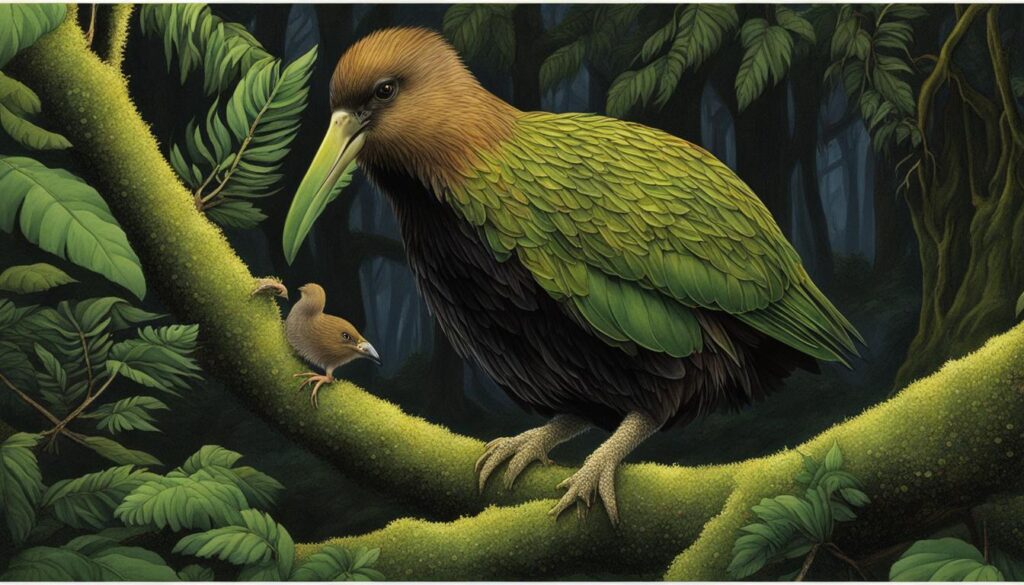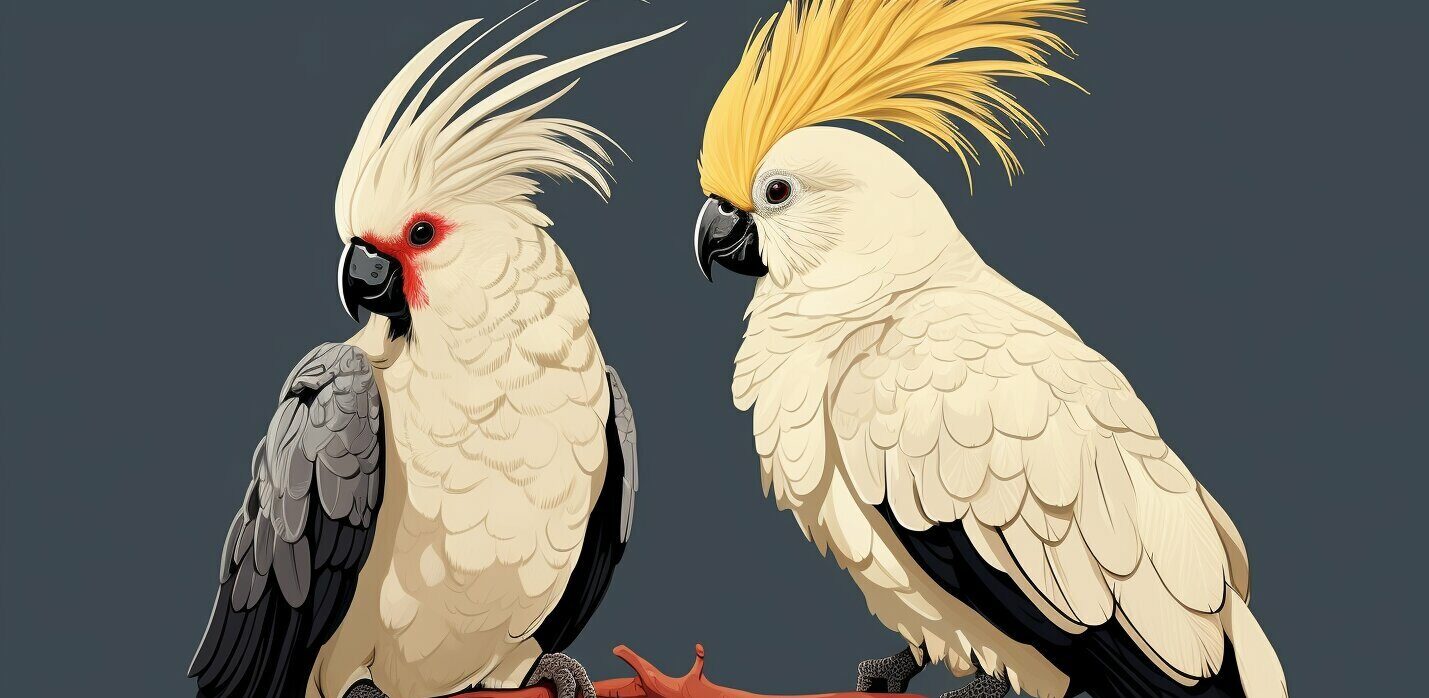Kiwis and Kakapos are two unique bird species found in New Zealand. While they share some similarities, there are distinct differences between them. Kiwis are flightless birds known for their small size and distinctive beak, while Kakapos are also flightless and are the world’s heaviest parrots. Kiwis primarily inhabit forests, while Kakapos are found in various habitats. The diet of Kiwis consists mainly of invertebrates, while Kakapos are herbivorous. Each species has its own set of characteristics and features that make them fascinating and distinct from each other.
Key Takeaways:
- Kiwis and Kakapos are unique bird species found in New Zealand.
- Kiwis are flightless birds known for their small size and distinctive beak.
- Kakapos are the world’s heaviest parrots and also flightless.
- Kiwis primarily inhabit forests, while Kakapos are found in various habitats.
- Kiwis are carnivorous, while Kakapos are herbivorous.
Nesting Behavior and Habitat
Kiwis and Kakapos have distinct nesting behaviors and habitats that contribute to their unique lifestyles.
Kiwis, being primarily forest dwellers, build their nests in crevices of rocks, hollow bases of trees, or hollow logs. They use leaves and sticks for construction, creating cozy and hidden spaces for their eggs and young.
On the other hand, Kakapos choose to make their nests in hollow bases of trees or on the ground. They use plants and foliage to construct their nests, which provide protection and camouflage for their eggs and chicks.
| Kiwis | Kakapos |
|---|---|
| Nesting Behavior | Nesting Behavior |
| Kiwis build nests in crevices of rocks, hollow bases of trees, or hollow logs | Kakapos make their nests in hollow bases of trees or on the ground |
| They use leaves and sticks for construction | They use plants and foliage for construction |
In terms of habitat, Kiwis prefer dense forests and grasslands where they can find ample food sources and suitable nesting sites. These areas provide the necessary cover and resources for their survival.
Kakapos, on the other hand, have a wider range of habitats. They inhabit not only forests but also grasslands, savannas, and tropical areas. Their adaptability allows them to thrive in diverse environments.
The diverse nesting behaviors and habitats of Kiwis and Kakapos showcase the intricacies of their respective ecological niches and contribute to the fascinating biodiversity of New Zealand.
Physical Characteristics
Kiwis and Kakapos display distinct physical characteristics that set them apart from each other. These unique features contribute to their individuality and make them easily identifiable.
Kiwis
Kiwis have pale brownish or white feathers, which help them blend into their forest habitat. They have a small body size, ranging from 45 cm to 65 cm in length, and weigh around 2 to 4 kg. One of the most recognizable features of a Kiwi is its long beak, which is slender and curved, resembling a probe. Kiwis also have a distinctive crest of plume-like feathers on the top of their heads. Their eyes are usually brown or hazel in color. These physical characteristics allow Kiwis to navigate through dense vegetation and hunt for their preferred prey, such as beetles, worms, and insects.
Kakapos
Kakapos, on the other hand, have a striking appearance with their black, greenish, and yellow feathers. Their vibrant coloration serves as a form of camouflage, helping them hide among the leaves and branches of trees. Kakapos are the heaviest parrots in the world, ranging from 55 cm to 65 cm in length and weighing between 2 to 4 kg. Like Kiwis, Kakapos also have a crest on their head, but it is generally more vibrant and can vary in color. Their eyes are ivory-colored, which adds to their unique appearance. These physical characteristics allow Kakapos to navigate through diverse habitats and forage on various plant-based foods, including leaves, fruits, and berries.
| Kiwis | Kakapos | |
|---|---|---|
| Feather Color | Pale brownish or white | Black, greenish, and yellow |
| Body Size | 45 cm – 65 cm in length, 2 – 4 kg in weight | 55 cm – 65 cm in length, 2 – 4 kg in weight |
| Beak | Long, slender, and curved | N/A |
| Crest | Distinctive plume-like feathers on the head | Distinctive crests of varying colors |
| Eyes | Brown or hazel | Ivory-colored |
These physical characteristics not only contribute to the visual appeal of Kiwis and Kakapos but also play a significant role in their survival and adaptation to their respective environments.
Behavior and Diet
Kiwis and Kakapos exhibit different behaviors and have distinct diets. Kiwis are nocturnal birds, being most active during the night, while Kakapos are diurnal, being active during the day. This difference in activity patterns allows them to occupy different ecological niches within their habitats, minimizing competition for resources.
Kiwis are carnivorous, feeding on a variety of invertebrates including beetle grubs, insects, snails, worms, and spiders. They use their long beaks to probe the ground in search of food, and their keen sense of smell helps them locate prey. With their strong leg muscles, they can easily dig into the soil to find hidden snacks.
On the other hand, Kakapos are herbivorous, primarily feeding on plants, fruits, and berries. Their diet consists of a wide range of vegetation, including leaves, shoots, seeds, bark, and flowers. With their strong beaks, they can crack open seeds and extract nutritious parts from various plant sources.
“Kiwis and Kakapos have adapted to their respective environments by developing specialized diets. While Kiwis rely on a high-protein diet to sustain their energy needs, Kakapos have evolved to efficiently digest plant material and extract nutrients from a herbivorous diet.” – Bird Expert
Habitat Influence on Behavior and Diet
The different behaviors and diets of Kiwis and Kakapos are closely linked to their respective habitats. Kiwis primarily inhabit forests, where their nocturnal behavior helps them avoid predators and find prey in the darkness. The dense vegetation provides ample cover for hunting, allowing Kiwis to take advantage of the abundant invertebrates present in this ecosystem.
Kakapos, on the other hand, inhabit a wider range of habitats including forests, grasslands, savannas, and tropical areas. Their diurnal behavior allows them to make use of available daylight to forage for food. The varied plant life in these habitats provides them with a diverse array of food sources to meet their nutritional requirements.
| Behavior | Kiwis | Kakapos |
|---|---|---|
| Activity Pattern | Nocturnal | Diurnal |
| Diet | Carnivorous | Herbivorous |
The different behaviors and diets of Kiwis and Kakapos reflect their unique adaptations to their environments. Understanding these differences helps us appreciate the diverse ways in which birds have evolved to survive and thrive in their habitats.

Reproduction and Life Span
Kiwis and Kakapos have unique reproductive behaviors and life spans that contribute to their distinct characteristics and survival strategies. The breeding patterns and life cycles of these two bird species showcase fascinating differences.
Reproduction
When it comes to breeding, Kiwis and Kakapos have distinct approaches. Kiwis reach sexual maturity at around 3 years of age, while Kakapos take longer, reaching maturity at around 7 years. Both species lay 1 to 2 eggs in a clutch, but the incubation period and parental care vary.
For Kiwis, both parents contribute to incubating the eggs, taking turns to keep them warm for about 70 to 75 days. Kakapos, on the other hand, have a shorter incubation period of around 30 to 35 days, and the female is the sole caretaker during this time. This difference in parental involvement reflects the unique adaptation strategies employed by each species.
Life Span
The life span of Kiwis and Kakapos also differs significantly. On average, Kiwis have a relatively shorter life span, living for about 10 years. In contrast, Kakapos have an impressive life span of around 55 years. The longevity of Kakapos allows them to thrive and adapt to their environments over an extended period, contributing to the stability of their populations.
These differences in reproductive behaviors and life spans highlight the diverse strategies and adaptations that Kiwis and Kakapos have developed to ensure their survival in their respective habitats. Understanding these aspects of their biology provides valuable insights into the ecological significance of these bird species in New Zealand’s biodiversity.
| Reproduction and Life Span Comparison | ||
|---|---|---|
| Aspect | Kiwis | Kakapos |
| Sexual Maturity | Around 3 years | Around 7 years |
| Egg Clutch | 1 to 2 eggs | 1 to 2 eggs |
| Incubation Period | 70 to 75 days | 30 to 35 days |
| Parental Care | Both parents | Female |
| Average Life Span | Approximately 10 years | Approximately 55 years |
Conclusion
Kiwis and Kakapos are two unique bird species that inhabit the diverse landscapes of New Zealand. Although they share similarities, such as being flightless, each species has distinct characteristics that set them apart.
The diet of Kiwis consists mainly of invertebrates, making them carnivorous birds. On the other hand, Kakapos are herbivorous, primarily feeding on plants, fruits, and berries. These dietary differences reflect the ecological niches each species has adapted to in their respective habitats.
Not only do Kiwis and Kakapos differ in their diet, but also in their nesting behavior and habitat preferences. Kiwis build nests in crevices of rocks, hollow bases of trees, or hollow logs, while Kakapos make their nests in hollow bases of trees or on the ground. Kiwis prefer dense forests and grasslands, while Kakapos inhabit forests, grasslands, savannas, and tropical areas.
Overall, Kiwis and Kakapos contribute to the rich biodiversity of New Zealand and continue to captivate researchers and bird enthusiasts alike. Their distinct physical characteristics, behaviors, diets, reproductive strategies, and life spans make them fascinating subjects of study. Protecting and preserving their habitats is crucial to ensuring the long-term survival of these remarkable bird species.
FAQ
What are the main differences between Kiwis and Kakapos?
Kiwis are small flightless birds, while Kakapos are the world’s heaviest parrots. They also have different habitats and diets.
Where do Kiwis and Kakapos build their nests?
Kiwis build nests in crevices of rocks, hollow bases of trees, or hollow logs, while Kakapos make their nests in hollow bases of trees or on the ground.
What are the physical characteristics that distinguish Kiwis and Kakapos?
Kiwis have pale brownish or white feathers, while Kakapos have black, greenish, and yellow feathers. Kiwis have a distinctive crest on their head, while Kakapos also have crests but in different colors.
What is the difference in behavior and diet between Kiwis and Kakapos?
Kiwis are nocturnal and carnivorous, feeding mainly on invertebrates. Kakapos are diurnal and herbivorous, primarily feeding on plants, fruits, and berries.
How do the reproductive behaviors and life spans of Kiwis and Kakapos differ?
Kiwis reach sexual maturity at around 3 years, while Kakapos reach maturity at around 7 years. Kiwis lay 1 to 2 eggs in a clutch, with an incubation period of 70 to 75 days. Kakapos also lay 1 to 2 eggs in a clutch, but the incubation period is shorter, around 30 to 35 days. Kiwis have a life span of about 10 years on average, while Kakapos have a much longer life span of around 55 years.
 Skip to main content
Skip to main content


